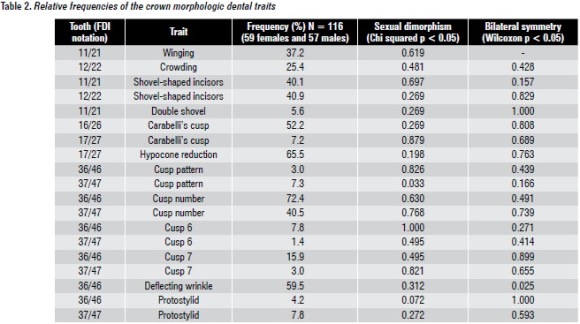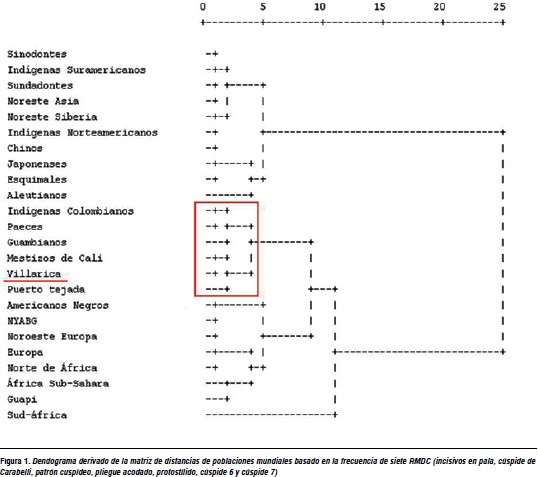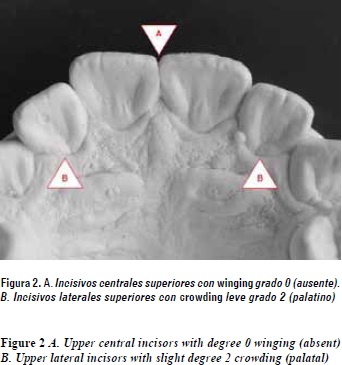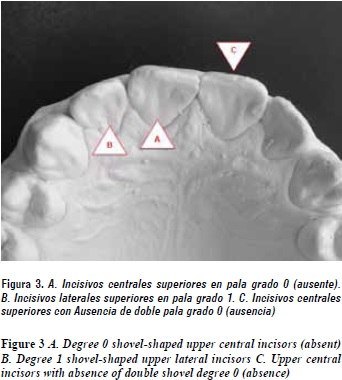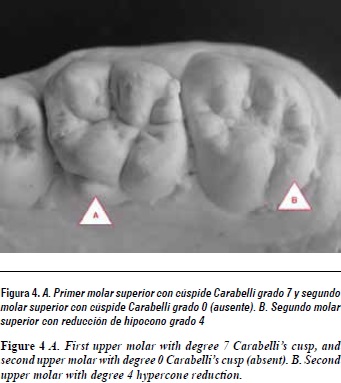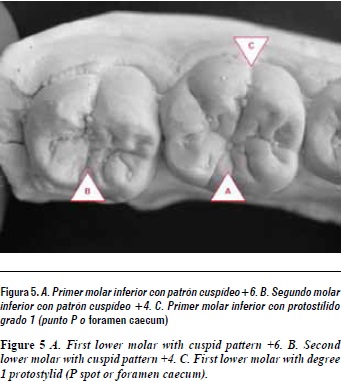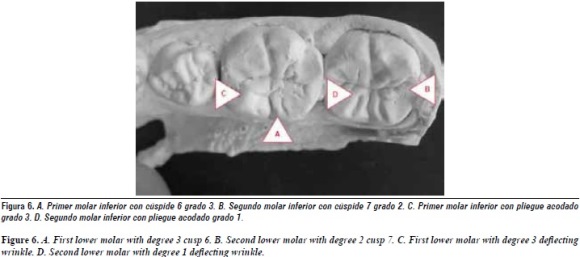Services on Demand
Journal
Article
Indicators
-
 Cited by SciELO
Cited by SciELO -
 Access statistics
Access statistics
Related links
-
 Cited by Google
Cited by Google -
 Similars in
SciELO
Similars in
SciELO -
 Similars in Google
Similars in Google
Share
Revista Facultad de Odontología Universidad de Antioquia
Print version ISSN 0121-246X
Rev Fac Odontol Univ Antioq vol.24 no.1 Medellín July/Dec. 2012
ORIGINAL ARTICLES DERIVED FROM RESEARCH
DENTAL MORPHOLOGY ANALYSIS OF AFRO-COLOMBIAN SCHOOLCHILDREN FROM VILLA RICA, CAUCA, COLOMBIA
Isabella Marcovich1, Eliana prado 1, Paola Díaz 1, Yenny Ortiz 1, Carlos Martínez 2, Fredy Moreno3
1 Senior Undergraduate Students, Institución Universitaria Colegios de
Colombia, Colegio Odontológico, Cali
2 Dentist, Magister in Epidemiology, Professor, Institución Universitaria
Colegios de Colombia, Colegio Odontológico, Cali
3 Dentist, Magister in Biomedical Sciences, Professor, School of Health,
Universidad del Valle, Professor, School of Health, Pontificia Universidad
Javeriana, Cali
SUBMITTED: SEPTEMBER 27/2011-ACCEPTED: APRIL 17/2012
Marcovich I, Prado E, Díaz P, Ortiz Y, Martínez C, Moreno F. Dental morphology analysis of Afro-Colombian schoolchildren from Villa Rica, Cauca, Colombia. Rev Fac Odontol Univ Antioq 2012; 24(1): 37-61.
ABSTRACT
INTRODUCTIONthe study of dental morphology allows establishing the evolutionary state (biological distance and
crossbreeding status) of a community, offering information on its ethno-historical processes (in this case a Colombian population) within
the anthropological, dental, and forensic contexts.
METHODS: this was a quantitative, transversal, descriptive study with the intention of
establishing dental morphology by means of the Asudas system (Arizona State University Dental Anthropology System) based on thirteen
crown morphologic dental traits (winging, crowding, shovel-shaped central incisors, shovel-shaped lateral incisors, double shoveling,
Carabelli's cusp, hypocone reduction, deflecting wrinkle, protostylid, cusp pattern, cusp number, cusp 6, and cusp 7)
RESULTSsignificant frequencies of these traits were observed: Carabelli's cusp, configuration of cuspid patterns X5 and X6 (LM1) and +4 and +5 (LM2),
absence of hypocone reduction, relative frequency of cusp 7, and low frequencies of shovel-shaped incisors and double shoveling. It
may also be stated that the studied crown morphologic dental traits (CMDT) do not show sexual dimorphism or bilateral asymmetry
CONCLUSIONSthe analyzed sample shows a dental morphology typical of populations of the Caucasoid dental complex; however, the
influence of Mongoloid groups and biological affinities with Caucasoid mestizo groups and Afro-Colombian populations is also evident.
Key words: dental anthropology, dental morphology, crown morphologic dental traits, biological distance.
INTRODUCTION
Colombia is considered to be a multicultural, polygenic, multilingual country with a population of over 40 million people, out of which about 10.2 million (nearly 26% of the nation's total population) are Afro-Colombian. Nevertheless, this diversity makes it difficult to perform not only demographic classifications (such as geographical region and territory, common biological background, language and cultural traditions, conscience of ethnical adscription, and self-recognizing) and socioeconomic projections, but also forensic procedures that include the four basic identification traits and general osteobiography (sex, age, racial pattern, and height) and identification of microevolutive development of Colombian population, which includes Caucasoid mestizos, indigenous peoples, afro-descendant populations, and the rom people or gypsies, based on land settlement processes, migrations, contacts, isolations, and crossbreeding.11
Similarly, anthropologist Rodríguez points out that according to the historical demographic process that took place in the Colombian territory, the principal population groups would include Andean mestizos, coastal mestizos (from the Atlantic and Pacific regions), indigenous, and Afro-Colombians.2
According to DANE (Departamento Administrativo Nacional de Estadística), the Afro-Colombian or Afro-descendant population would include four important groups: the ones located by the Pacific coastline, the raizales from San Andrés, Providencia, and Santa Catalina archipelago, the community of San Basilio de Palenque, and the population living in capital cities or big cities—which is exactly the case of the Afro-Colombian population of the municipality of Villa Rica.1
Arrival of African slaves in Colombian territory
During the 16th, 17th, and 18th centuries, Spanish settlers focused their economy on mining, establishing the encomienda with the purpose of controlling indigenous labor.
The indigenous populations soon experienced a demographic crisis which was solved by importing African slaves for such occupations. Between 1560 and 1650, an average 1.800 slaves entered the Colombian territory via Cartagena, coming from the banks of Guinea, Angola, Cape Verde, Sierra Leone, Arará, Mina, Carabalí, and Congo rivers at the subtropical and equatorial African regions (Senegambia, Ivory Coast and Pepper Coast, Gold Coast, Bight of Benin and Biafra, Central Africa, Sudan, South Bantu, and Mozambique); consequently, by the end of the 19th century there were almost 210.000 black slaves, although one of the first census includes only 16.468 slaves, out of which nearly 3.000 were located in the region of Cauca river. However, there are not enough studies to exactly determine the origin of Afro-American settlements in Colombia or the number of individuals that were brought from Africa.3-6
The different studies that have tried to establish the biogeographic and ethnic background of these peoples have started from two types of evidence: sociocultural data (linguistic or historical information or data related to family names or cultural patterns in order to establish similarities among a great amount of African peoples and their American descendants) and molecular data by means of analysis of classic markers such as mtDNA and Y chromosome. On the other hand, few studies include analysis of phenotype teeth patterns, either morphological or metrical, even though it has been widely demonstrated that dentition offers critical information to determine patters of biological variety and evolutionary adaptation of antique or current human populations. In particular, morphologic dental patterns have proven to be of great help to establish genetic and phylogenetic affinity among populations, and for clarifying their origins and microevolution.7
Afrocolombians from Villa Rica
In an extensive region located between the states of Valle del Cauca and Cauca, the "Hacienda de campo" developed as the prevailing economic model during the period between the 17th and the 19th centuries, consisting on agriculture, mining, black slaves trading, and cattle farming latifundium.
This type of hacienda became the base of socioeconomic power and paved the way for a smallholding peasantry of a commercial economy.6 Currently, Villa Rica is a municipality of the State of Cauca, located at southwestern Colombia, with a population of about 15.000 people, most of them of negroid groups; 96% of this population describe themselves as black (raizal, palenquero, black, mulatto, Afro- Colombian or afro-descendant).8
Dental Morphology
The study of dental morphology or odontoscopy implies the process of registration, analysis, and understanding of all the information that coronal and radicular morphology of the teeth may reveal about biological relations among populations due to their function as intergroup markers that enable comparative analyses to establish the history, origins, formation, contacts, isolation, and displacement of past and current human groups.9
The morphologic analysis of dental crowns is performed by means of crown morphologic dental traits (CMDT), which shape phenotypic forms of the enamel expressed and regulated by the genome of a given individual and of a population during odontogenesis. These morphologic characteristics may be either positive structures (tubercular or radicular) or negative structures (intertubercular of phosomorphes and may potentially make part of a specific place (frequency) in different manners (variability) in one or more members of a given population. So far, more than 100 dental morphologic traits have been identified in human dentition but most of the studies worldwide use only up to seventeen traits, especially the ones located at the crown of incisors and at the molars of both dentitions.9, 10 Unfortunately, the country's black populations have not been studied from the perspective of dental and craniofacial morphology, and most studies within the scope of dental anthropology focus on the forensic approach and on the study of oral morbidity and dental morphology of the pre-Hispanic populations.11
Consequently, considering that the sample exemplifies the population where it was obtained, and that phenetic similarities offer the index of genetics relation, the main objective of this study was to identify the biological relations of a sample of Afro- Colombian schoolchildren living in the municipality of Villa Rica, by analyzing frequency and variability, sexual dimorphism, bilateralism, and correlation among the traits of thirteen CMDTs: winging, crowding, shovel-shaped central incisors, shovel-shaped lateral incisors, double shoveling observed in central incisors and upper lateral permanent incisors (11, 21, 12, 22, FDI notation), Carabelli's cusp and hypocone reduction observed in upper molars (16, 26, 17, 27, FDI notation), deflecting wrinkle, protostylid, cusp pattern, cusp number, cusp 6, and cusp 7 observed in lower molars (36, 46, 37, 47, FDI notation). The results of this study will provide data about biological distance, evolutionary status, paths and displacements, and the crossbreeding status of the study population, offering valuable information on the historical processes of Afro-Colombian communities within anthropological, dental, and forensic frameworks.
MATERIALS AND METHODS
Population and sample
This was a transversal, descriptive, observational study on the frequency and variability of thirteen CMDTs in permanent teeth of 116 schoolchildren of both sexes (59 females and 57 males) who make part of the Afro-Colombian population and who go to a school of the municipality of Villa Rica, Cauca. The patients are between ten and eighteen years old, and they are Colombian, with Colombian parents and grandparents; they have healthy dental diagnosis, with no orthopedic or orthodontic appliances, no congenital anomalies, and no attrition, abfractions or severe abrasions. They have upper lateral and central incisors, as well as first and second upper and lower molars totally erupted. They were conveniently selected after a survey and an intraoral examination. The study included those children who agreed on participating and whose parents signed an informed consent.
Standardization and morphological analysis
In order to analyze the thirteen CMDTs in permanent teeth the Asduas method was used. This system allows observing the presence/absence dichotomy (frequency) and its different expression degrees (gradation); similarly, it promotes replication among observers in order to generate data about minimum and maximum expression of a given trait in several degrees of expression between the two points of reference.12. For accurate observation and gradation of the selected CMDTs, the authors performed a standardization process by means of plaster models representing the same characteristics according to the sample's inclusion and exclusion criteria. The observers learned how to manipulate the Asduas system during eight months; they observed and analyzed the plaster models with a 10x magnifying glass in order to obtain the first reference data. Two observations were later made under standardization protocols and double masking in order to control bias and achieve unification of observation criteria. In order to estimate the degree of reliability, a kappa test was applied in the Stata® software version 6.0; this result provided the observer with the best calibration with a concordance of 80,3% interobserver and 82,2% intraobserver, according to the study by Nichol and Turner II13 (tabla 1).
Field work and observations
Once the study had been approved by the Ethics Committee of Institución Universitaria Colegios de Colombia, according its ethical principles for medical research on human beings, as indicated by the World Medical Association of the Helsinki Declaration,14and after the parents signed their informed consent and authorization to perform intraoral examinations and to obtain plaster models, the work with each of the 116 children initiated. The researchers obtained impressions of each dental arch (both upper and lower), by means of Coe ID® plastic trays totally sterile, and loaded with alginate Hydrogum® as registration material. The plaster models were performed on commercial type III plaster Americano® (Hydrocal Gypsum) closely following the manufacturer's instructions in relation to the properties of these biomaterials and indications for manipulation of alignate and plaster, respectively. Observation of the thirteen CMDTs on plaster models was performed by means of a 10x magnifying glass and a Hu-Friedy® fine tip explorer.
Statistical analysis
The data obtained by observation were registered in an Excel® worksheet and were processed by the SPSS® software version 12.
A univariate and frequency analysis was performed by means of Chi squared in each of the CMDTs in order to determine sexual dimorphism, and Wilcoxon for bilateral symmetry. A p > 0.005 value was considered to be statistically significant.
The Stata software version 10.0 was later used to determine the correlations of these CMDTs: shovel-shaped incisors (11 versus 12, 21 versus 22, FDI notation), Carabelli's cusp (16 versus 17, 26 versus 27, FDI notation), cusp pattern (36 versus 37, 46 versus 47, FDI notation), cusp number (36 versus 37, 46 versus 47, FDI notation), cusp 6 and cusp 7 (36 versus 37, 46 vs 47, FDI notation), and protostylid (36 versus 37, 46 versus 47, FDI notation) by means of the Spearman non-parametric correlation test.
To determine biological distances, we used the distance matrix based on hierarchical clusters classification , by means of squared Euclidean; and the dendogram was obtained by means of the Ward method.
RESULTS
Frequencies of these thirteen CMDTs were observed in 116 schoolchildren of both sexes (59 females and 57 males) who make part of the Afro-Colombian population and who go to a school of the municipality of Villa Rica, Cauca.
Significant differences of these CMDTs were observed: Carabelli's cusp, configuration of cusps X5 and X6 (36, 46, FDI notation), and +4 and +5 (37, 47, FDI notation), absence of hypocone reduction, relative frequency of cusp 7, and low frequency of shovel-shaped incisors and double shovel, which are typical of the groups belonging or influenced by populations of the Caucasoid dental complex. However, significant differences of deflecting wrinkle and protostylid degree 1 (foramen caecum) suggest that the sample has received influences from mongoloid regional groups, as in the case of paeces and guambianos who inhabit this region. Similarly, the CMDTs studied do not present sexual dimorphism or bilateral asymmetry (table 2) .
In the case of correlations among CMDTs we have to take into account that Spearman correlation coefficient range from -1 to 1. The null hypothesis is that Rho equals zero, that is, no correlation exists in the expression of traits?or traits are independent. If values of this coefficient are close to 1 it means that there is more correlation or dependence; the opposite would mean independence.
Let`s observe then that shovel-shaped incisors (11, 12, 21, 22, FDI notation) present high correlation; protostylid (36, 37, 46, 47, FDI notation) present moderate correlation; and Carabelli's cusp (16, 17, 26, 27, FDI notation) and cusp pattern (36, 37, 46, 47, FDI notation) present low correlation, while cusp number, and cusp 6 and 7 between lower molars do not present any kind of correlation (tabla 3)
Interpretation of Spearman correlation coefficient (Rho): 0 = no relation; 0-0,2 = very low relation; 0,2-0,4 = low relation; 0,4-0,6 = moderate relation; 0,6-0,8 = high relation; 0,8-1 = very high relation; 1= prefect relation.
In order to establish biological affinity with world human populations, African populations, and afrodescendant American and Colombian populations, a distance matrix was performed obtaining a dendogram which allowed calculating macroevolutive biological relations among the sample, based on geographical, sociocultural, and biological models of distribution and behavior of population groups different to the frequency of these CMDTs: incisors in shovel, Carabelli's cusp, cusp pattern, protostylid, cusp 6, and cusp 7.
This dendogram showed that the studied sample presents a dental morphology very similar to that of other groups of southwestern Colombia, such as the case of Caucasoides from Cali, Afro-Colombians from Puerto Tejada, paez indigenous, guambiano indigenous, and the average Colombian indigenous populations. Similarly, distance among the clusters suggest that the sample from Villa Rica has a morphology very similar to that of Western Europe groups, American and Colombian afro-descendants (guapi), and groups from Sub-Saharan Africa and North Africa, thus corroborating the influence of the Caucasoid dental complex and the African origin of the study population (figure 1).
DISCUSSION
Dental Morphology
Winging and crowding
Rotation of upper central incisors or wining describes the rotation of one or both upper central incisors in relation to the middle line. The behavior of this trait has been associated to narrow alveolar arches that hinder the correct incisors aligning, and it is considered mesolingual rotation of both incisors (degrees 1 and 2) as the product of genetic factors characteristic of Native American populations, while rotation of one single tooth or both teeth in distolingual direction (degrees 3 and 4) is due to crowding.
Crowding of upper lateral incisors has been explained as a consequence of disharmony between the size of the dental alveolus and lateral incisors, and therefore these teeth tend to migrate towards palatal behind the central incisors and the upper canines. This type of crowding is more frequent among mongoloid populations and less frequent among Caucasoid populations,12, 15 according to presence/absence dichotomy. Winging y Crowding are considered to be absent from the sample (figura 2).
Shovel- and double shovel-shaped lateral and central incisors
The shovel shape, formed by the palatal or lingual fossa and mesial/distal marginal crests, may be observed in the palatal surface of upper lateral and central incisors. On the other hand, the double shovel shape or vestibular shovel is described as prominent mesial and distal vestibular marginal crests.16 In the studied sample, we could observe a significant frequency of the expression of shovel-shaped lateral and central incisors (40.1 and 40.9%, respectively) while the double shovel shape is considered to be absent (5.6%) (figura 3).
Carabelli's cusp
It is located at the palatal surface of the meso-palatal cusp of first and second upper molars. It is considered to be the most characteristic CMDT of the Caucasoid dental complex; North African populations have a tendency to the expression of large cusps. In the sample from Villa Rica, a high prevalence of this trait was observed in first molars (52,2%), but not so much in second molars; nevertheless, due to the dichotomy presence/absence expression, the most frequency was observed in phosomorphs 3 and 4, which are characteristic of the Paleoindian populations, including Colombian indigenous peoples.9 We should also bear in mind that cuspid expressions do not imply crossbreeding with regional populations of Caucasoid origin, as the studied sample comes from populations that make part of the Caucasoid dental complex, which include both African groups and Western Europe groups (figure 4).
Hypocone reduction
Severe reduction and absence of distolingual cusp or hypocone is a tendency observed from the first upper molars towards the second upper molars. This CDTM has not been associated to any world dental complex but its highest frequencies are observed in sinodonts, fist subdivision of Mongoloid dental complex. The lowest frequencies have been observed in populations of Oceania and in sundadonts, second subdivision of the Mongoloid dental complex, characterized by simplification of dental morphology.9 In the present sample, a significant presence of hypocone reduction has been observed in second upper molars (65,5%) (figure 4).
Cusp pattern and cusp number
Cusp pattern of permanent lower first and second molars describes the number of cusps and the way they contact each other. The classical pattern is the Y one or "dryopitecine", a prototype of past Asian populations. X and + o configurations or "cruciform" are considered to be reductions, frequently observed in Caucasoid groups.15
In this study, absence of the Y cuspid pattern was observed, but predominance of X5 and X6 (3,0 and 72,4%, respectively) in the first lower molar, and +4 and +5 in the second one (7,3 and 40,5%, respectively)—typical patterns of grouped afrodescendant populations of the Caucasoid dental complex (figure 5).
Cusps 6 and 7
Cusp 6 occasionally appears between distolabial and distolingual cusps of first and second lower molars, while cusp 7 is usually located at the marginal edge between distolingual and mesolingual cusps of the same teeth.9 Both in first and second molars, these two CDTMs were absent from this sample (figura 6).
Deflecting wrinkle
This is a morphological trait that describes the way mesolingual cusp moves towards the central pit of the first lower molars. It is considered to be an important marker of sinodont populations of Northeast Asia grouped in the Mongoloid dental complex.9
The significant frequency in the present sample (59,5%) clearly indicates influence of such complex by crossbreeding with indigenous groups during the historical processes of the region (figura 6).
Protostylid
This CDTM is defined as a trait belonging to the Mongoloid dental complex.9 Nevertheless, the expression of the P spot orforamen caecumis typical of Paleoindian populations.17 According to the methodology used to define this trait, it was considered to be absent from the sample (figure 5).
Correlations among CDTMs
According to the morphogenetic fields theory suggested by Butler in 1939 (cited by Scott and Turner)12, each tooth type (incisors, canines, premolars, and molars) has a variation gradient that is genetically well preserved and has received very little influence from the environment. Thus, the central incisor is the gradient of the incisor field, the canine is the gradient of the canine field, and the first molar of the molar field. From this gradient, the other teeth of the same class experience not only a reduction in size but also in the expression (frequency) and variability (gradation) of the CDTMs, producing structure simplification.
This situation is much more evident among the molars, as the CDTMs of the first molar, both upper and lower, experience a reduction up to the third molar—a tooth that, along with upper lateral incisors and lower second premolars, has received the greatest environmental influences?.9 This is why low and middle expressions occur in the correlations of CDTMs among first and second upper molars (16/26 y 17/27, FDI notation) and the and second lower molars (36/37 y 46/47, FDI notation) while among upper central incisors (11/12, FDI notation) and upper lateral incisor (21/22, FDI notation) the trait of shovel-shaped incisors presented a high correlation. The same results were reported by Edgar and Lease,18 Smith et al,19 and Ocampo et al.20
Biological affinity of the sample
Dental patterns and their geographical distribution, as suggested by Hanihara,21, Turner22 and Scott and Turner,12 by means of the study of 29 CDTMs (thirteen of which were considered in this study), classify human beings in five clusters: The Mongoloid dental complex formed by cynodont and sundadont groups, the Caucasoid dental complex, formed by the groups from Western Eurasia (Europe, North Africa, the Middle East and India), the Saharan Africa dental complex (formed by the subgroups of Western Africa and South Africa, much more closed to the sundadont populations of the South Pacific), the groups of south Pacific or Oceania, and the American Paleoindians.23
We must take into account that, according to Turner,24 the American continent was initially occupied by sinodont human groups—first subdivision of the Mongoloid dental complex—characterized by shovel-shaped incisors, deflecting wrinkle, Y6 cusp pattern, protostylid, and winging, such as the case of populations of Northern Asia that migrated from Northern China and crossed Beringia. It is possible to state then that all of the American indigenous groups present a sinodont dental morphology, and based on dental analysis this may therefore suggest a great genetic affinity among American indigenous populations, which make up an only cluster considered as Paleoindian and Mongoloid.9, 25, 26
Similarly, Zoubov17introduced the Americanoide dental complex, integrated by all the American Paleoindians, and very similar to the Mongoloid due to the high rates of shovel-shaped incisors, deflecting wrinkle, 6 cusp, and degree 1 protostylid (P spot or foramen caecum).It is important to point out, however, that dental evaluations of some prehistorical populations of southern Peru and Northern Chile dating back more than 7.000 years present sundadontic characteristics—second subdivision of the Mongoloid dental complex—characterized by a simplified dental morphology typical of populations of Southeast Asia.27
Later on, human groups from Western Europe settled down in the American territory in three subsequent historical processes known as discovery, conquest, and colonization. These groups, belonging to the Caucasoid dental complex, are characterized by a simplified dental morphology reflected in low frequencies of: shovel-shaped incisors and double shoveling, deflecting wrinkle, and cusps 6 and 7. However, the CDTMs that more commonly characterize these groups are: a higher frequency of cuspid expression of the Carabelli's cusp, and cuspid patterns X and +.23
Again Zoubov17 suggested that the Caucasoid dental complex may be divided in two groups: a Northern one, with high Mongoloid influence characterized by high frequencies of shovel-shaped incisors, +5 cuspid patter, and Carabelli's cusp (cuspid shapes), and a southern one, characterized by the absence of shovel-shaped incisors, Y3 and Y4 cuspid patterns, and in general a very simplified dental morphology similar to that of sundadontic groups. In the case of Eastern Equatorial populations, the subgroups come from the Western or African region considered to be the same as southern Caucasoid or Negroid, with low frequency of Carabelli's cusp and high frequency of cusp 7, as well as from the Easter or Melanesian region considered to be the same as the Mongoloid dental complex. According to Scott and Turner,12 groups from Saharan Africa are characterized by low frequencies of shovel-shaped incisors and double shoveling, and high frequencies of cusp 7 and Y cuspid pattern at the second lower molar.
Based on worldwide scientific evidence and the diverse dendograms that assemble the different human groups in geographical clusters, several researchers have studied samples of past and present afro-descendant communities in order to clarify the origins of Afro-American populations based on the ethno-historical processes occurred since the 16th century and the forced diaspora of individuals belonging to Negroid human groups brought to the new continent as slaves. Unfortunately, there are few studies on this topic worldwide. In the specific case of Colombia, there is not enough documentation for reconstructing the past of afro-descendant peoples, starting by the lack of information on the regions where these individuals were taken and sold as slaves in the newly founded American colonies.5 Concerning research on the field of dental anthropology, the situation is very similar. Studies on dental morphology and the behavior of CMDTs in Negroid human groups are scarce and not much information is available. Jackson et al28 suggested that the dental registrations of bone remains of more than 200 individuals excavated form a cemetery of African slaves of the 16th and 17th centuries in New York (New York African Burial Ground NYABG) present a wide range of biological affinity with populations of North and South Africa, considering the frequencies of Carabelli's cusp, Y cusp pattern, and cusp 7.
In the case of Colombia, Rocha et al11 studied eleven CDTMs in a group of Afro-Americans from Puerto Tejada (Cauca) finding out high frequencies of Carabelli's cusp of medium size (degree 5), cusp patterns +5 and +6, and cusp 7; they associated this finding with the influence of Western dental complex (Caucasoid and Negroid). Also, they noticed high frequencies of protostylid (P spot of foramen caecum) and deflecting wrinkle; they associated this finding to Mongoloid influences due to crossbreeding with regional indigenous groups. This was corroborated in the corresponding dendogram, as the Puerto Tejada sample showed the same cluster of Colombian indigenous groups, such as paeces, guambianos, and mestizos from Cali, indicating a high affinity among these populations due to strong historical crossbreeding processes in southeastern Colombia, specifically on the Cauca river valley. Similarly, this population group is directly related to the cluster of populations from Europe, North Africa, Negroid Americans, and the cemetery of African slaves found in New York; this is an indication of a clear biological affinity with the Caucasoid dental complex.
It is not possible to establish the exact origins of the sample analyzed in the present study, but we may conclude that there exists a high degree of crossbreeding with Caucasoid groups and regional indigenous groups due to the diverse ethnographic, social, and historical processes that took place in the region, just as the dendogram proves it, as it shows the Villa Rica sample in the cluster of samples from Colombian indigenous populations, such as paeces, guambianos, mestizos from Cali and Afro-Colombians from Puerto Tejada. This may be associated to significant frequencies of shovelshaped incisors, Carabelli's cusp (especially occurring by phosomorphs 3 and 4), cusp patterns + and Y with molars of 5 and 6 cusps, deflecting wrinkle, degree 1 protostylid(foramen caecum) and cusp 7. Also, the Villa Rica sample may be associated to Afro-descendant populations of North America, Western Europe, and North Africa (as it belongs to the Caucasoid dental complex) and subsequently to populations of Sub-Saharan Africa and guapi. This totally agrees with the postulates by Edgar23 and Delgado-Burbano,7, 29 who point out that Afro-American populations, including the Afro- Colombian ones, descend from African ancestors who came to the continent as slaves from Western and Mid-Western Africa, and to a lower extent from Eastern, Southeastern, and Northern Africa. Likewise, the relations among the cluster formed by populations from regions of Valle del Cauca and Cauca support the postulates by Moreno et al30 and Rocha et al,11 who suggest that this region specifically witnessed a considerable crossbreeding process among indigenous groups (Mongoloid dental complex) Europeans (Caucasoid dental complex), and Africans (Caucasoid and sub-Saharan complexes)given the aforementioned historical conditions. Consequently, this supports the classifications proposed by dental anthropologists in terms of the relations occurring among the clusters in different regional and world dendograms.
CONCLUSIONS
Considering the significant frequencies of Carabelli's cusp, cusp patterns X5 and X6 (36 and 46) and +4 and +5 (37 y 47), the relative frequency of cusp 7, the low frequencies of shovel-shaped incisors and double shovel, and the absence of hypocone reduction, one may conclude that the studied sample has a dental morphology typical of populations that make part of the Caucasoid dental complex.
The studied sample showed neither sexual dimorphism nor bilateral asymmetry in CDTMs frequency. Similarly, the CDTMs correlation among 11/12 and 21/22, 16/26 and 26/27, 36/37 and 46/47 is not significant, except for the trait of shovel-shaped incisors, supporting the morphogenetic fields theory.
Concerning biological affinity, due to sociocultural historical processes that took place in Southeastern Colombia during the last 500 years, the dendogram makes it clear that there has been influence from regional groups of Mongoloid origin as well as biological affinity with regional groups of Caucasoid mestizos and Afro-Colombians.This situation clearly suggests that the geographical region of Cauca river valley has experienced a strong crossbreeding process among the principal ethnic groups that have inhabited the Southeastern Colombian region: Amerindians, Caucasoids and Negroids.
ACKNOWLEDGMENTS
The authors want to thank Institución Educativa Senón Fabio Villegas of the municipality of Villa Rica, Cauca, for allowing integrating the sample for this research project with its students.
CORRESPONDING AUTHOR
Freddy Moreno
School of Health. Universidad del Valle
Cali, Colombia
email address: freddymorenogomez@yahoo.com.co
REFERENCES
1. Rodríguez E, Hernández A, Salamanca LM, Ruiz FA. Colombia: una nación multicultural. Su diversidad étnica. Bogotá: Departamento Administrativo Nacional de Estadísticas; 2007. [ Links ]
2. Rodríguez JV. La antropología forense en la identificación humana. Bogotá: Universidad Nacional de Colombia; 2004. [ Links ]
3. Colmenares G. La esclavitud en la Gobernación de Popayán 1680-1780. En: I Congreso Nacional de Antropología; Popayán 1978. Documento mimeografiado. [ Links ]
4. Gutiérrez-Azopardo A. Historia del negro en Colombia: sumisión o rebeldía. 2.ª ed.. Bogotá: Nueva América; 1986. [ Links ]
5. Friedemann NS. La saga del negro. [libro en línea] 1993 [fecha de acceso junio de 2005]; URL disponible en: http://www.lablaa.org/blaavirtual/antropologia/saga/indice. [ Links ]htm
6. Aprile-Gniset J. Los pueblos negros caucanos y la fundación de Puerto Tejada. Cali: Gobernación Valle del Cauca; 1994. Serie Autores Vallecaucanos. [ Links ]
7. Delgado-Burbano ME. Variación dental no-métrica y el tráfico de esclavos por el atlántico: la ascendencia biológica y los orígenes geográficos de una población afro-colombiana. Rev Esp Antrop Fís 2007; 27: 13-32. [ Links ]
8. Colombia. DANE. Boletín Censo General 2005: Perfil Cauca-Villa Rica. [en línea] 2005 [fecha de acceso julio de 2009]; URL disponible en: URL disponible en: http://www.dane.gov.co/ [ Links ]
9. Rodríguez JV. Dientes y diversidad humana: avances de la antropología dental. Bogotá: Universidad Nacional de Colombia; 2003. [ Links ]
10. Rodríguez CD. La antropología dental y su importancia en el estudio de los grupos humanos prehispánicos. Revista de Antropología Experimental 2004; 4: 1-7. [ Links ]
11. Rocha L, Rivas H, Moreno F. Frecuencia y variabilidad de la morfología dental en niños afro-colombianos de una institución educativa de Puerto Tejada, Cauca (Colombia). Colomb Med 2007; 38: 210-221. [ Links ]
12. Turner II CG, Nichol CR, Scott GR. Scoring procedures for key morphological traits of the permanent dentition: The Arizona State University Dental Anthropology System. En: Nelly MA, Larsen CS (Eds). Advances in dental anthropology. New York: Wiley-Liss; 1991. [ Links ]
13. Nichol CR, Turner II CG. Intra and inter-observer concordance in classifying dental morphology. Am J Phys Anthropol 1986; 69: 299-315. [ Links ]
14. Asociación Médica Mundial. Principios éticos para las investigaciones médicas en seres humanos, Declaración de Helsinki. [en línea] 1964 [fecha de acceso enero de 2005]; URL disponible en: http://www.wma.net/s/policy/b3.htm [ Links ]
15. Rodríguez JV. Introducción a la antropología dental. Cuad Antropol 1989; 19: 1-41. [ Links ]
16. Mizoguchi YS. A statistical analysis of its morphology. [en línea] 1985 [fecha de acceso marzo de 2009]; 26 URL disponible en: http://www.um.utokyo.ac.jp/publish_db/Bulletin/no26/no26000.html [ Links ]
17. Zoubov AA. La antropología dental y la práctica forense. Maguaré 1998; 13: 243-252. [ Links ]
18. Edgar HJH, Lease LR. Correlations between deciduous and permanent tooth morphology in a european american sample. Am J Phys Anthropol 2007; 133: 726-734. [ Links ]
19. Smith P, Koyoumonsky-Kaye E, Kaldaron W, Stern D. Directionality of dental trait frequency between human second deciduous and first permanent molars. Arch Oral Biol 1987; 32: 5-9. [ Links ]
19. Ocampo AM, Sánchez JD, Martínez C, Moreno F. Correlación de diez rasgos morfológicos dentales coronales entre molares deciduos y permanentes en tres grupos étnicos colombianos. Rev Estomat 2009; 17(2): 7-16. [ Links ]
20. Hanihara T. Dental and cranial affinities among populations of East Asia and the Pacific: the basic populations in east Asia, IV. Am J Phys Anthropol 1992; 88: 163-182. [ Links ]
21. Turner II CG. Major features of sundadonty and sinodonty including suggestions about east Asian microevolution, population history and late Pleistocene relationships with Australian aboriginals. Am J Phys Anthropol 1990; 82: 295-317. [ Links ]
22. Edgar HJH. Microevolution of African American Dental Morphology. Am J Phys Anthropol 2007; 132: 535-544. [ Links ]
23. Turner II CG. Advances in the dental search for native American origins. Acta Anthropogen 1984; 8: 23-78. [ Links ]
24. Scott GC, Turner II CG. The anthropology of modern human teeth: dental morphology and its variation in recent human populations. London: Cambridge University Press; 1997. [ Links ]
25. Hanihara T. Morphological variation of major human populations based on non-metric dental traits. Am J Phys Anthropol 2008; 136: 169-182. [ Links ]
26. Sutter RC. Prehistoric genetic and culture change: a bioarchaeological search for pre-inka altiplano colonies in the coastal Valleys of Moquegua, Perú, and Azapa, Chile. Lat Am Antiq 2000; 11(1): 43-70. [ Links ]
27. Jackson FLC, Mayes A, Mack ME, Froment A, Keita SOY, Kittles RA et al. Origins of the New York African burial ground population: biological evidence of geographical and macroethnic affiliations using craniometrics, dental morphology, and preliminary genetic analyses. En: National Park Service U. S. Department of the Interior. The African burial ground project: skeletal biology final report-volume I [libro en línea] 2006 [fecha de acceso agosto de 2009]; URL disponible en: http://www.africanburialground.gov/ABG_FinalReports.htm [ Links ]
28. Delgado-Burbano ME. Population affinities of African Colombians to Sub-Saharan Africans based on dental morphology. HOMO J Comp Hum Biol 2007; 58: 329-356. [ Links ]
29. Moreno F, Moreno SM, Díaz CA, Bustos EA, Rodríguez JV. Prevalencia y variabilidad de ocho rasgos morfológicos dentales en jóvenes de tres colegios de Cali, 2002. Colomb Med 2004; 35 (Supl 1): 16-23. [ Links ]











 text in
text in 

